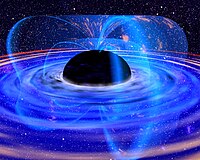
Photo from wikipedia
The dynamical formation of black hole binaries in globular clusters that merge due to gravitational waves occurs more frequently in higher stellar density. Meanwhile, the probability to form intermediate mass… Click to show full abstract
The dynamical formation of black hole binaries in globular clusters that merge due to gravitational waves occurs more frequently in higher stellar density. Meanwhile, the probability to form intermediate mass black holes (IMBHs) also increases with the density. To explore the impact of the formation and growth of IMBHs on the population of stellar mass black hole binaries from globular clusters, we analyze the existing large survey of Monte-Carlo globular cluster simulation data (MOCCA SURVEY Database I). We show that the number of binary black hole mergers agrees with the prediction based on clusters' initial properties when the IMBH mass is not massive enough or the IMBH seed forms at a later time. However, binary black hole formation and subsequent merger events are significantly reduced compared to the prediction when the present-day IMBH mass is more massive than $\sim10^4 \rm M_{\odot}$ or the present-day IMBH mass exceeds about 1 per cent of cluster's initial total mass. By examining the maximum black hole mass in the system at the moment of black hole binary escaping, we find that $\sim$ 90 per cent of the merging binary black holes escape before the formation and growth of the IMBH. Furthermore, large fraction of stellar mass black holes are merged into the IMBH or escape as single black holes from globular clusters in cases of massive IMBHs, which can lead to the significant under-population of binary black holes merging with gravitational waves by a factor of 2 depending on the clusters' initial distributions.
Journal Title: Monthly Notices of the Royal Astronomical Society
Year Published: 2020
Link to full text (if available)
Share on Social Media: Sign Up to like & get
recommendations!